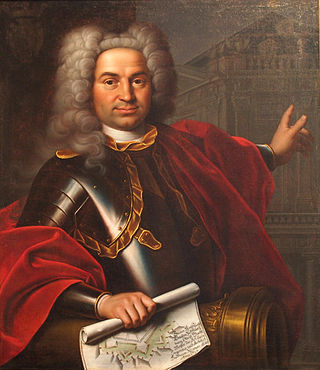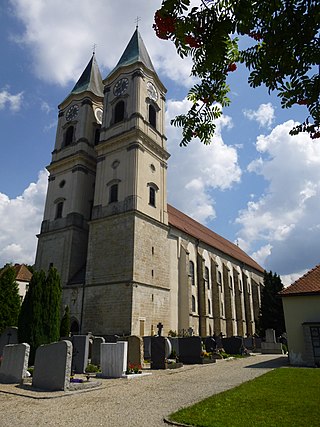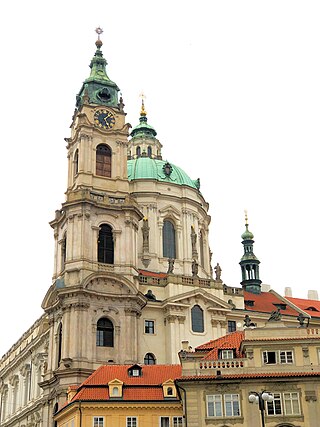
Johann Balthasar Neumann, usually known as Balthasar Neumann, was a German architect and military artillery engineer who developed a refined brand of Baroque architecture, fusing Austrian, Bohemian, Italian, and French elements to design some of the most impressive buildings of the period, including the Würzburg Residence and the Basilica of the Fourteen Holy Helpers.

Malá Strana or historically Menší Město pražské is a district of the city of Prague, Czech Republic, and one of its most historic neighbourhoods.

František Maxmilián Kaňka was a Czech architect. He was among the most important and most prolific Baroque architects in the Czech lands.

The House of Schönborn is the name of an ancient noble and formerly sovereign family of the Holy Roman Empire. As a former ruling and mediatized family, it belongs to the Hochadel.
The year 1751 in architecture involved some significant events.

Kilian Ignaz Dientzenhofer was a German Bohemian architect of the Baroque era. He is among the most prolific and renowned architects of his era in Bohemia. He was born into the well known Dientzenhofer family of architects and is considered its most talented and productive member.

Christoph Dientzenhofer was a Bavarian architect of South-German, Austrian and Bohemian Baroque. He was a member of the famous Dientzenhofer family of architects, and the father of Kilian Ignaz Dientzenhofer.

Niederaltaich Abbey is a house of the Benedictine Order founded in 741, situated in the village of Niederalteich on the Danube in Bavaria.

Banz Abbey, now known as Banz Castle, is a former Benedictine monastery, since 1978 a part of the town of Bad Staffelstein north of Bamberg, Bavaria, southern Germany.

Břevnov Monastery is a Benedictine archabbey in the Břevnov district of Prague, Czech Republic. It was founded by Saint Adalbert, the second Bishop of Prague, in 993 AD with the support of Bohemian Duke Boleslaus II. The first Benedictine male monastery in Bohemia, it also has the oldest tradition of beer brewing in the Czech Republic. Brewing was interrupted several times in the history, but up to today, the Břevnov Monastery Brewery brew its beer here.

Loreta is a pilgrimage destination in Hradčany, a district of Prague, Czech Republic. It consists of a cloister, the church of the Lord’s Birth, the Santa Casa and a clock tower with a famous chime.

Johann Dientzenhofer was a builder and architect during the Baroque period in Germany.
The year 1707 in architecture involved some significant events and new architectural works.

The Prince-Bishopric of Bamberg was an ecclesiastical State of the Holy Roman Empire. It goes back to the Roman Catholic Diocese of Bamberg established at the 1007 synod in Frankfurt, at the behest of King Henry II to further expand the spread of Christianity in the Franconian lands. The bishops obtained the status of Imperial immediacy about 1245 and ruled their estates as Prince-bishops until they were subsumed to the Electorate of Bavaria in the course of the German Mediatisation in 1802.
Leonhard Dientzenhofer was a German builder and architect from the well known Dientzenhofer family of architects.
5318 Dientzenhofer, provisional designation 1985 HG1, is a stony background asteroid from the inner regions of the asteroid belt, approximately 6 kilometers (3.7 miles) in diameter. It was discovered on 21 April 1985, by Czech astronomer Antonín Mrkos at the Kleť Observatory in Bohemia, Czech Republic. The transitional S-type asteroid has a rotation period of 8.06 hours. It was named after the German Baroque architects Christoph and Kilian Ignaz Dientzenhofer.

Michaelsberg Abbey or Michelsberg Abbey, also St. Michael's Abbey, Bamberg is a former Benedictine monastery in Bamberg in Bavaria, Germany. After its dissolution in 1803 the buildings were used for the almshouse Vereinigtes Katharinen- und Elisabethen-Spital, which is still there as a retirement home. The former abbey church remains in use as the Michaelskirche.

The Church of Saint Nicholas is a Baroque church in the Lesser Town of Prague. It was built between 1704 and 1755 on the site where formerly a Gothic church from the 13th century stood, which was also dedicated to Saint Nicholas. It has been described as the greatest example of Prague Baroque.

Czech Baroque architecture refers to the architectural period of the 17th and 18th century in Bohemia, Moravia and Silesia, which comprised the Crown of Bohemia and today constitute the Czech Republic.

























